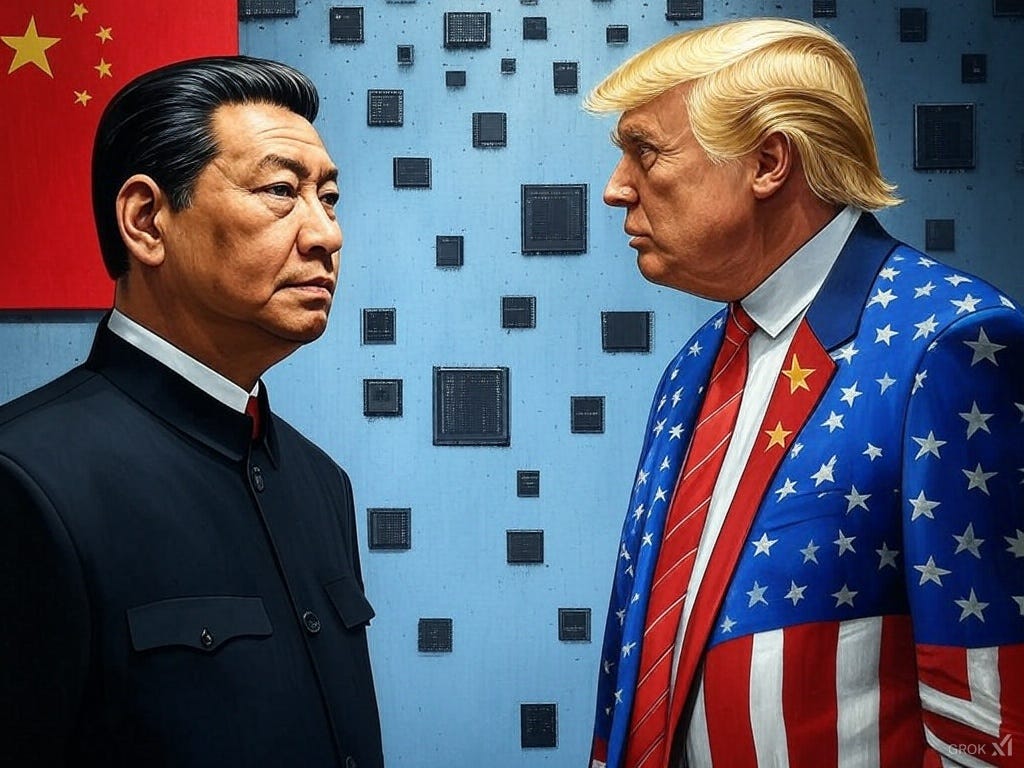The AI Arms Race: U.S., China, and the Path to Grok 3
History of the AI arms race, where control of Nvidia's H100 chips plays a major role in giving the US an advantage over China.
The showdown between the United States and China over artificial intelligence (AI) has become the defining tech rivalry of our era—a high-stakes sprint toward a super-advanced AI, often dubbed the Singularity. What started as a quest for innovation has escalated into a geopolitical chess match, with microchips as the kingmakers and the recent release of Grok 3 by xAI marking a pivotal move.
A Brief History of the AI War
The U.S. laid the groundwork for modern AI in the 2000s, driven by Silicon Valley ingenuity and academic breakthroughs. By 2016, it was a national priority, with Barack Obama declaring, “The nation that goes all-in on AI will lead the 21st century.” China countered in 2017 with a bold plan to dominate AI by 2030, fueled by vast data and state investment. As Eric Schmidt, former Google CEO, warned, “China is catching up fast—by 2025, they could be neck-and-neck.” The U.S. responded with export controls, turning hardware into a weapon to preserve its lead.
The Chips and Memory Driving AI
Training cutting-edge AI demands elite hardware. Nvidia’s H100 GPUs are the crown jewels, offering unrivaled power for crunching massive datasets behind models like ChatGPT or Grok. “The H100 is the engine of the AI revolution,” says Jensen Huang, Nvidia’s CEO. “Without it, you’re stuck in the slow lane.” Paired with high-bandwidth memory (HBM3), these chips slash training times from months to days, making them indispensable for data centers chasing the next AI leap.
U.S. Restrictions to Hold the Line
Since October 2022, the U.S. has tightened the screws on China’s access to this tech. The Department of Commerce banned exports of advanced GPUs like the H100, HBM, and chip-making tools from firms like ASML. By 2024, updates capped GPU shipments to third countries—over 100 nations face limits—and set strict quotas (e.g., 1,700 H100s annually without licenses). “We’re not just protecting our lead; we’re shaping the future,” said Commerce Secretary Gina Raimondo in 2023. The goal? Keep China reliant on outdated hardware while U.S. firms race ahead.
China’s Defiant Push
China’s response is a mix of grit and guile. Huawei’s Ascend 910B chips are stepping up, though they trail Nvidia’s best. “We’ll build our own destiny,” vowed Huawei’s rotating chairman, Guo Ping, in 2022. SMIC, China’s top chipmaker, is squeezing older tech (7nm) for results, while black-market smuggling of banned GPUs fills gaps—albeit at a trickle. Leveraging its data advantage, China focuses on deploying AI in real-time systems, from surveillance to logistics, buying time until its domestic tech matures.
The Singularity Prize
The ultimate target is the Singularity—an AI so advanced it outstrips human intellect, self-improving to solve problems we can’t fathom. “Whoever wins this race will rewrite the global order,” predicts Elon Musk, xAI’s founder. A nation wielding such power could crack encryption, dominate markets, or reshape warfare, securing its interests for decades. The U.S. sees it as a democratic safeguard; China, a tool for centralized supremacy.
Grok 3 and the H100 Advantage
Enter Grok 3, released by xAI in February 2025. This latest iteration, built to accelerate human scientific discovery, underscores America’s edge. Musk recently secured 200,000 Nvidia H100 chips for xAI’s data centers—a haul China can only dream of under current restrictions. With each H100 locked behind U.S. export walls, China’s Ascend chips and smuggled GPUs can’t match this scale or speed. “Those 200,000 H100s are a game-changer,” Musk tweeted. “It’s raw compute power China can’t touch—yet.” Training Grok 3 on this arsenal positions xAI, and the U.S., closer to the Singularity than ever.
The Road Ahead
As of now, the U.S. leads, bolstered by Grok 3 and its hardware dominance. China’s resilience keeps it in the fight, but the H100 gap is a steep hill to climb. The Singularity looms as both prize and peril—whoever gets there first could dictate humanity’s future. For now, Grok 3’s release is a loud signal: the U.S. isn’t just playing defense; it’s charging toward victory.




